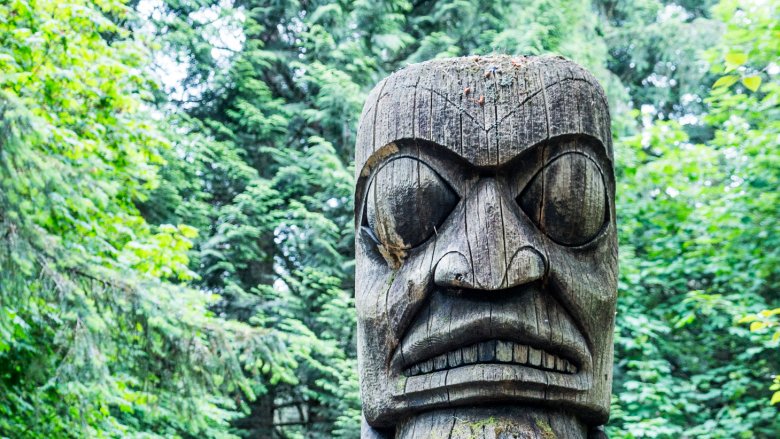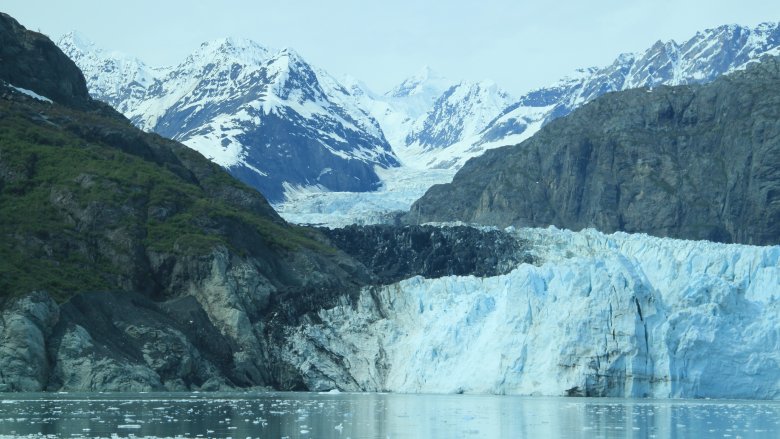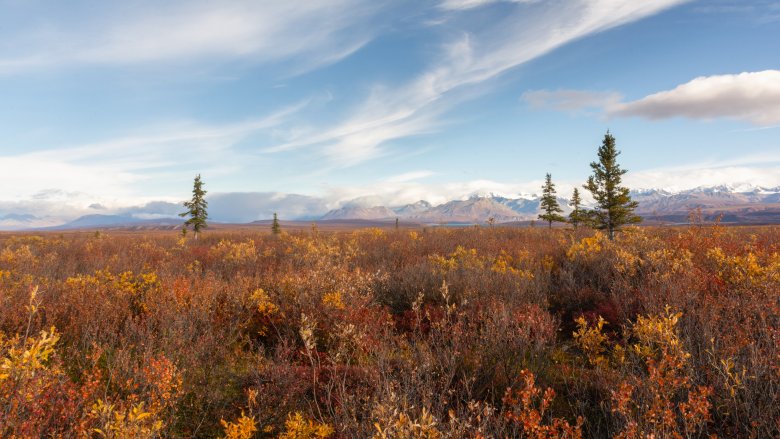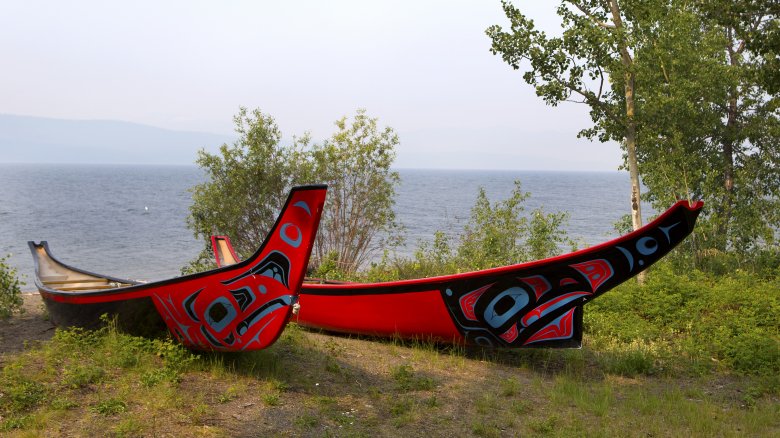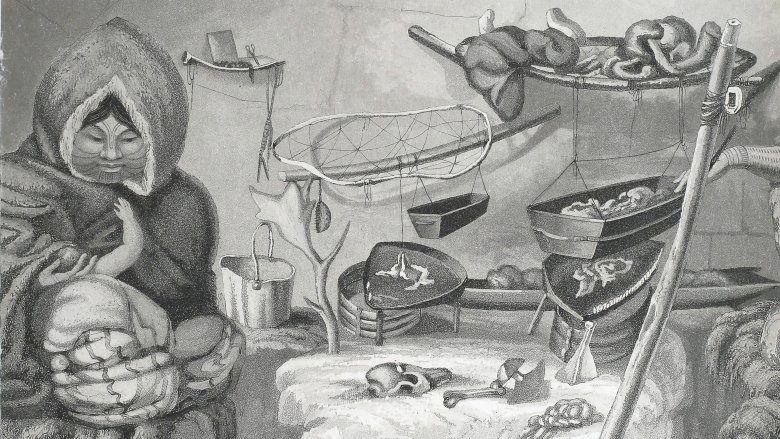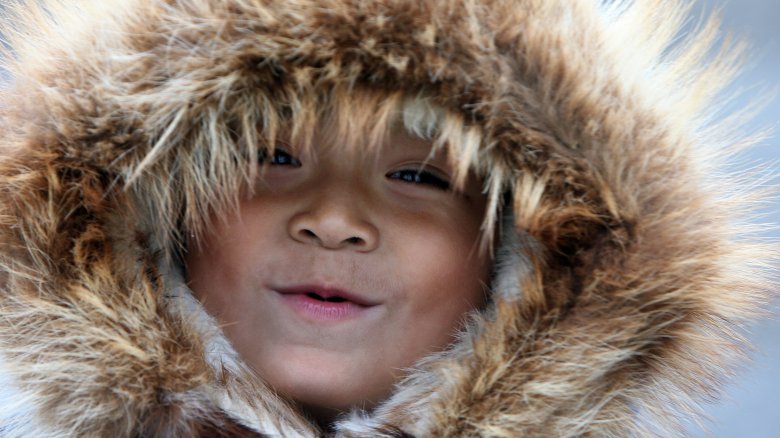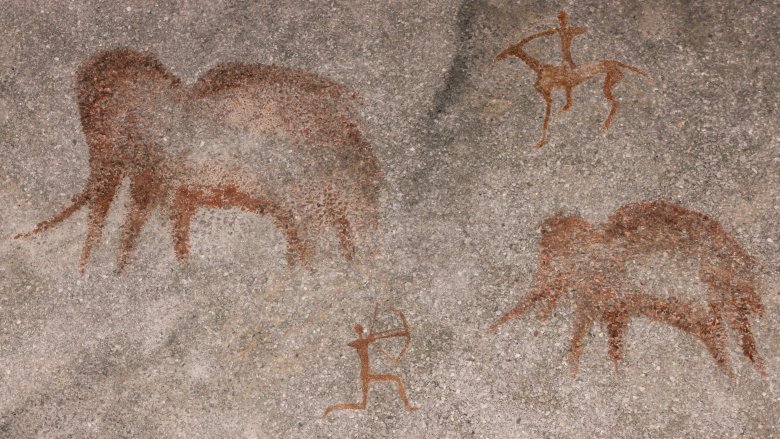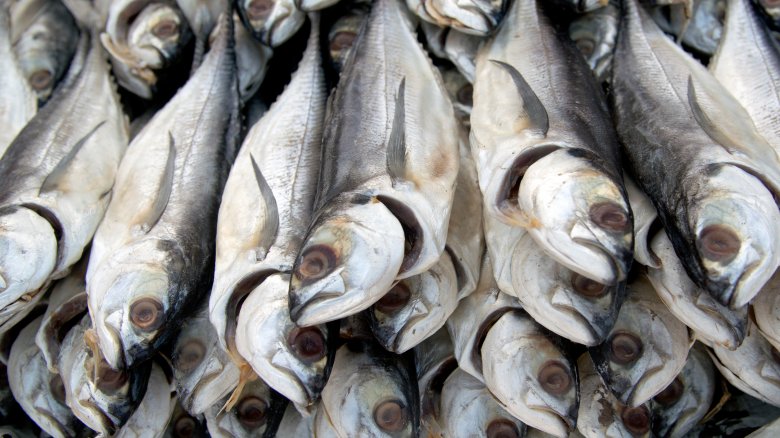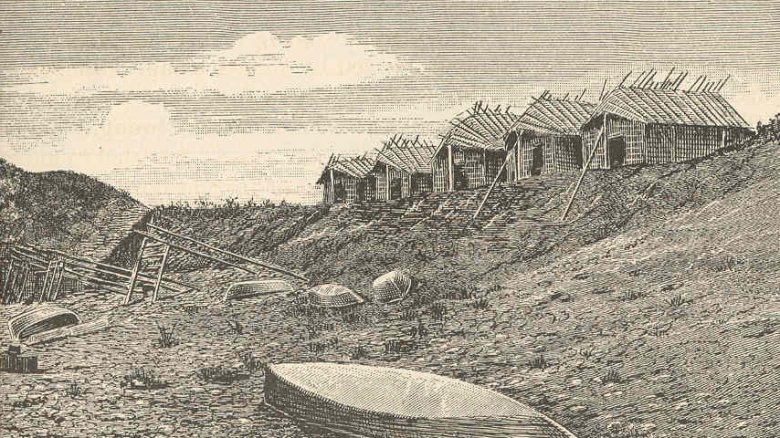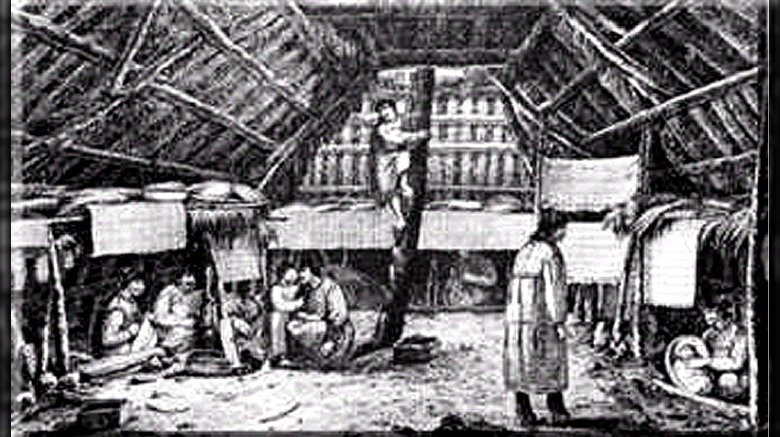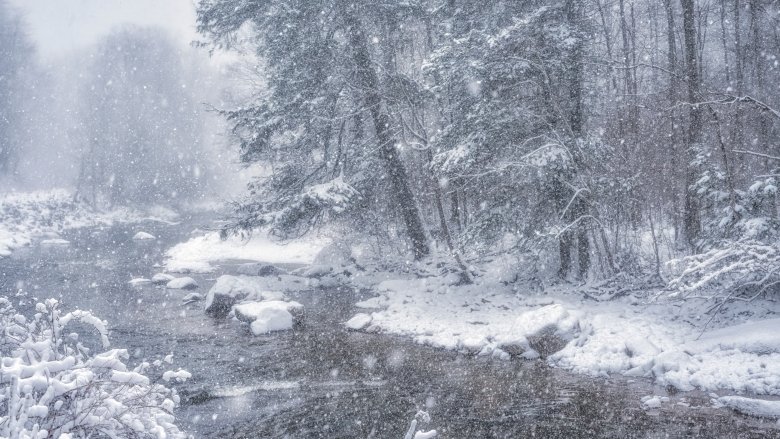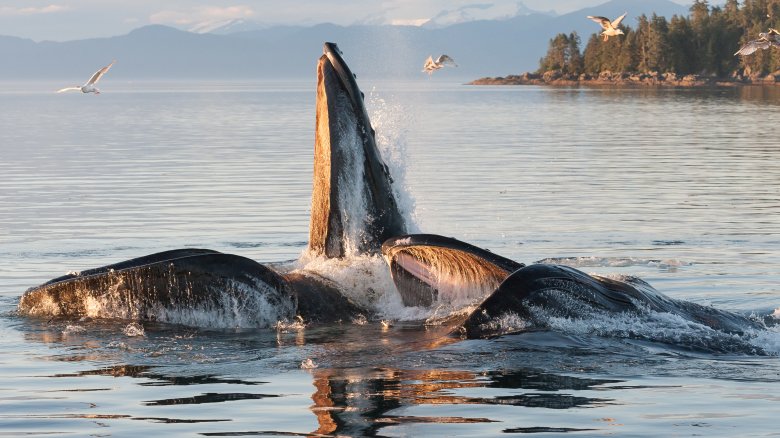What Pre-American Alaska Was Really Like
Alaska is beautiful, wild, and sometimes dangerous. Parts of it are mostly unspoiled, too, and when you visit it's easy to imagine that not much has changed in the last few thousand years. Surely that brilliant landscape looks pretty much the same as it did when humans first laid eyes on it 15,000 years ago.
But pre-American Alaska wasn't the same as it is now—the wildlife wasn't the same, the landscape wasn't the same, and it definitely didn't look the same. But more importantly, the people who lived in pre-American Alaska had to learn how to survive in a sometimes harsh and inhospitable landscape, and they didn't have the benefit of roads or supermarkets or Sarah Palin to make their lives easier and more entertaining. So what was it really like in pre-American Alaska? Cold. Really, really, cold. But besides that, yes, it was also beautiful, abundant, and challenging. Here's everything you didn't know about life in pre-American Alaska.
During the ice age, Alaska was not completely covered with ice
When you picture the Ice Age in your mind, you probably imagine a land choked by glaciers, with very little green. How exactly does one survive in a land where there is nothing but ice?
Well first, you need to dismiss that mind's-eye picture of what it looked like in Alaska during the Ice Age, because it's wrong. According to the University of Alaska, Fairbanks, the interior of Alaska was actually green during the last ice age. Wait, what the what now? While it is true that parts of the future-state were locked up in ice (Anchorage, the Alaska Peninsula, and south-central and southeast portions specifically), the interior was somewhat of a paradise. That's because so much of the world's oceans were frozen, that the sea level dropped by around 400 feet, exposing the Bering land bridge and briefly connecting Alaska and Siberia. All that extra land actually helped to further isolate the Alaskan interior from ocean moisture, which in turn led to warm summers and mild(er) winters.
So the weird truth is that Ice Age Alaska wasn't bitterly cold, bright white and inhospitable, or rather, not all of it. Parts of the state were in fact pretty inviting, at least from a Stone Age perspective.
People did cross the Bering land bridge, but first, they lived on it
As school kids, we all heard the story of travelers crossing the Bering land bridge into North America. But what weren't really told is where those travelers went once they arrived, and the answer is, not far. Those early people had no idea that they were walking on land that had once been covered by the sea, or that the sea would one day cover it again. All they saw was a land rich in game and wood, and when it's cold outside, those two things are valuable resources.
According to The Conversation, the first people to cross the Bering land bridge didn't exactly "cross" it. They saw no reason to. Instead, they settled there, hunting game and burning the shrub willow and birch in order to keep warm. And they likely remained there for thousands of years—in fact, there is little evidence of a genetic link between modern Native Americans and the people who lived in Siberia and East Asia during the time prior to the Bering migration. Those two populations diverged about 25,000 years ago, around the peak of the last ice age.
There also isn't any archaeological evidence that people were living in Siberia during the last ice age—they probably did live there 30,000 years ago, but those lands were largely abandoned when the ice started to move in. That suggests that the population moved on, to literally greener pastures.
Early Alaskan settlers may have escaped the rising waters by boat
We all know what happened at the end of the Ice Age. The glaciers retreated and the land began to flood. According to Sapiens, around 18,000 years ago a small trickle of people from Siberia may have joined those already living on the Bering land bridge. The newcomers brought stone points and other stone technology that would be useful for people hunting large animals in cold environments. Those particular kinds of tools are what helped archaeologists track the ancient people from Beringa into Alaska—the tools began to appear in the land of the midnight sun around 14,000 years ago.
No one is sure when the people of the Bering land bridge finally decided to move on, but as temperatures warmed it probably started to become pretty clear to them that their lands weren't going to continue to be habitable. But how did they get off Beringia? Some researchers think the rising waters may have separated the inhabitants of the land bridge before they really knew what was happening, and by the time it became obvious they needed to migrate to the mainland, it may have been too late to do so on foot. That means they would have had to develop some kind of seafaring technology to help them safely make the journey. In fact, according to some theories, some occupants of the former land bridge may have sailed down the coast all the way to South America.
The first Alaskans were genetically diverse
More than 11,000 years ago, two mothers buried their babies in the cold ground of their fishing camp in what is now modern Alaska. The infants were placed on red ocher and surrounded by hunting darts made out of antler. The care in which they were buried reminds us that ancient people loved and grieved exactly the way we do—but those two long-forgotten infants also gave archaeologists important insight into the genetic origins of Native Americans.
One of the two babies was between six- and 12-weeks-old, and the other was likely stillborn. They were buried in the same ceremonial fashion, but they were from two very different genetic lineages, neither of which are common in the modern population of Native Americans. So what does that mean? According to Smithsonian, it means that the people who lived in Alaska 11,500 years ago were a lot more genetically diverse than we thought. This find seems to support the theory that the people who crossed the Bering land bridge must have been isolated from their Siberian ancestors for a very long period of time.
The site where the two infants were buried also showed evidence that the people who lived there were fishing salmon. Archaeologists discovered salmon vertebrae that indicate that salmon was an important food source—this is the earliest evidence of salmon fishing in Alaska found to date.
People didn't arrive in Alaska in a single wave
We like to imagine that people showed up in North America in one big wave. They woke up one day and went, "Welp, Siberia sucks, let's go to America," and that was that. But that's not really how it happened. According to the Alaskan Department of Natural Resources, there was another major migration from Siberia somewhere between 7,000 and 4,500 years ago. By then the Bering land bridge was long gone, so it's likely that this group came by boat. But that wasn't the last time people migrated to Alaska from Siberia—the ancestors of the modern Inuit and Yup'ik people didn't arrive until around 800 years ago, which by the way is roughly 300 years before Christopher Columbus was all, "Hey look I discovered America!" Um sorry, dude, but Siberians have been discovering America for thousands of years.
But it's even more interesting than that—recent genetic research has revealed that people didn't just show up and put down roots. They went back and forth between Siberia and North America at least three times. The genes of the Inuit and Yup'ik's ancestors can actually still be found in some of the people living in Siberia.
Contrary to what you'd probably expect, people were not always suffering from the cold
If you've ever been to Alaska in the wintertime you know one thing: It's cold. And yet, the native Inuit people don't seem to especially care how cold it is—it's only the people of European ancestry who are constantly moaning about the temperature. Why is that? As it turns out, it isn't just that there are cultural guidelines against annoying everyone around you with your endless complaining (though frankly, American culture in general could do with some of those guidelines), it's that the Inuit people and the Siberians they are descended from actually possess a gene that makes them more tolerant to the cold. Yes, please.
So if you picture pre-American Alaska as a place where people were constantly miserable because it was so danged cold outside, well, that's not exactly correct. According to research published in Molecular Biology and Evolution, the unique gene that protects the Inuit from the misery of cold weather is similar to the one found in the Denisovans, an ancient human cousin. Some of the people who possess this gene variant live in parts of the world that Neanderthals once occupied, so scientists think this means that Inuits, Native Americans, and some Siberians have genetic ties to Denisovans, Neanderthals, or maybe some other human ancestor that hasn't yet been discovered.
Meanwhile, let's figure out how to splice that gene into some of the rest of us. Winter is coming.
Humans coexisted with some of Alaska's megafauna
So on a scale of one to unfreakingly-believably awesome, what would it have actually been like to coexist with the megafauna of Ice Age and post-Ice Age Alaska? Well, the people who crossed the Bering land bridge would have seen animals that are familiar to us, like bighorn sheep and elk, but as they moved into the interior they would have encountered creatures that would have turned we moderns into terrified piles of quivering bear food. The early settlers likely shared territory with animals that we can only imagine, such as woolly mammoths, American lions, and the terrifying giant short-faced bear which was about 12 feet tall when standing upright and therefore about four to seven feet larger than a grizzly bear and probably not very afraid of humans.
So did early Alaskans actually hunt mammoth, mastodon, and other large mammals? Yes, and some researchers think they even had a hand in those animals' eventual extinction. The fossil record seems to suggest that the decline of these species correlated with the migration of humans from Beringia into North America. Others, though, think it was mostly climate change—as the region warmed, the scrub tundra spread to the steppe and outcompeted the vegetation that larger herbivores depended on. Whatever the reason, it's pretty cool to think that human beings once looked out across the land and saw massive herds of mammoths, and sad to think that no one will ever see that again.
This is not the paleolithic diet you probably had in mind
At some point in recent human history, people got the weird idea that if we only just ate the things our ancestors ate, we'd all live longer and re-evolve sloping foreheads and extra body hair. Or something. Anyway, thus was born the paleo diet, which says humans shouldn't eat grains, legumes, and most dairy products, among other things. Why? Because our ancestors didn't. Except they did—according to Scientific American, Neanderthals were eating barley 40,000 years ago and people have been drinking milk for at least 7,500 years.
But more importantly, the diets of human beings varied pretty wildly depending on where they lived, so there is no real "paleolithic" diet. If you wanted to eat like a paleolithic Alaskan, for example, it would be pretty much meat and meat and meat and fish with meat for dessert, because there were very few plant foods. In southwest Alaska, people may have eaten things like berries, roots, seaweed, and certain types of greens, but generally speaking the people learned to subsist on animal products because that's what was abundant.
Permanent settlements didn't really start to appear in Alaska until 5,200 years ago
Most students of ancient history agree that agriculture was the key to civilization. Once people learned how to grow food and raise domesticated animals, they could build permanent settlements because there would no longer be the need to follow migrating herds or move on once all the roots had been gathered. In the old world, agriculture began about 12,000 years ago.
But in Alaska, there's no real tradition of farming. Instead, there's evidence that people were setting up permanent villages around the same time as they were harvesting very large amounts of food—for example, evidence for things like plank house construction and permanent hearths starts to appear in the archaeological record about 5,200 years ago, and by 3,200 years ago it's clear that people were skilled at building large wooden fish weirs for the mass harvest of salmon. According to the Alaskan Department of Natural Resources, these developments were followed by things like fortification, which suggests that villages were sometimes targeted by other clans. So yes, with civilization comes people who are jealous of your civilization. See, the native Alaskans really weren't so different from every other human civilization anywhere, like ever.
They lived in hobbit holes ... sort of
So what sort of a dwelling would you live in if you were a person who only had stone technology and you lived in a place where it was intolerably cold. Well, intolerably cold for someone without a magic cold-defying gene variant, but at least occasionally cold to the point where you might actually die if you weren't inside a really good shelter.
According to ThoughtCo., by 800 BC, the early Alaskans figured out that if you want to stay warm, you need insulation, and the best insulation is the ground under your feet. So they designed a semi-subterranean house that was either partially or completely underground, much like a hobbit hole only without the cool round doors and the low ceilings. Such a house was practically impervious to things like howling winds and blizzards because while the harshest weather can always take down a flimsy above-ground house, it can't go underground.
This style of construction was used for centuries, largely because it was so effective that no one saw any reason to change it. Houses dating from 1300 to 1700 AD still have the same basic design, though they got a little fancier as time went on. Later houses were commonly laid out with a large, oval-shaped central room with smaller side rooms for preparing food. The main room was accessed by a tunnel. Sounds cozy.
Climate change was a problem for Alaska then, too
Like us, the people of Beringia experienced a warming climate and had to cope with the consequences. For the earliest migrants, the changing climate led to the flooding of their homeland, and what might have been a terrifying and dramatic escape from a shrinking landscape. Of course, climate change for them was "it's freezing" to "it's less freezing," while climate change for us is "oh my God, the entire world is melting." But the first Americans had less technology at their disposal that could help them cope with the problem. Still, human ingenuity is a remarkable thing.
Between the 14th and 19th centuries, there was a cooling event known as the "Little Ice Age," which changed the availability of resources for the people of Alaska. According to ScienceDirect, excavation of a 16th-century site occupied by pre-contact Yup'ik people shows that the residents were harvesting salmon, marine mammals, and caribou, and also supplementing their diets with smaller mammals and birds. Interestingly, caribou weren't a huge source of food—they were important for the manufacture of the tools the people needed to harvest fish and marine mammals.
The change in climate likely made it necessary for the people to be flexible. Rather than depending on one primary source of food, they learned to shift between food sources as some became more abundant and others became scarce. They also learned to preserve food, which likely helped them get through the toughest times.
Whaling was important to some Alaskan cultures for thousands of years
Whaling today has a very, very bad rap, mostly because large commercial whaling operations were responsible for driving many species to the brink of extinction, and also, whales are cool and we like them. But for a lot of native Alaskan people, whales were an important resource, and the history of whaling in the area goes back at least 2,500 years, when the Eskimos of the Bering Sea were hunting whales in boats made of walrus hide or small kayaks. And really, the question is not how they were able to hunt such large animals in such small boats but how they were able to build the boats strong enough to support their giant cojones.
Anyway, according to ExploreNorth, the hunters would wound their prey with a harpoon and then sometimes follow it for days until it finally died, and if that sounds awful just try to remember how harsh the living conditions were for those ancient hunters and just how many meals one whale could represent.
Today whales are still a major source of food for the Inuit people, and for some cultures, the hunt is more about tradition than about subsistence. Either way, the practice is now controversial, and like so much of what made pre-American Alaska special, it may one day become a memory of the past.
